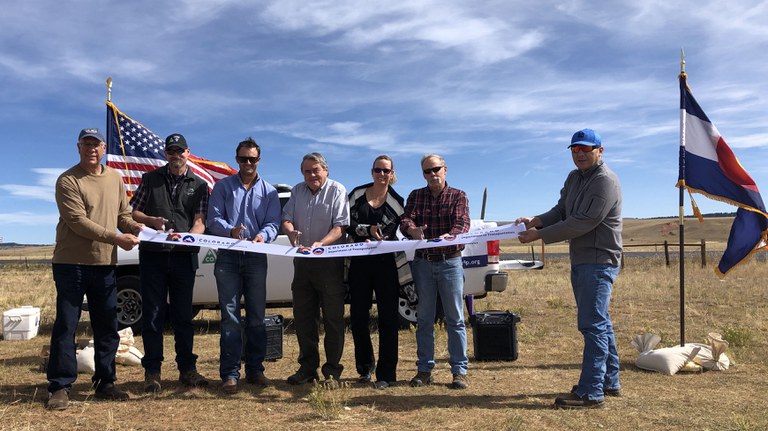US 285 Resurfacing Project Near Fairplay - Official ribbon cutting signifies completion of first project
FAIRPLAY, CO -- On Thursday, September 26, the Colorado Department of Transportation (CDOT) hosted a ribbon cutting ceremony at US 285 and County Road 5 to recognize the substantial completion of the US 285 Resurfacing Project.

Karen Rowe, CDOT Region 2 Transportation Director (RTD) welcomed guests and recognized the importance of the completion of this project improving safety and travel for all.
“We appreciate the cooperation from the traveling public as we worked to improve safety in this area,” said CDOT RTD Karen Rowe. “The work that was done over the past seven months is a great example of how we are improving road conditions and make traveling our highway system safe and enjoyable.” said Rowe.
The $11.2 million project was completed by Contractor APC Southern in a seven-month time-frame. “We had a rough start with long delays to complete work on the north end of the project,” said Dan Hunt, CDOT Project Engineer. “Once we moved south of Fairplay we were able to implement the daily CO 9/US 24 detour route Monday - Thursday. We received feedback that the traveling public preferred the detour route rather than the delays. This decision proved to be safer for the traveling public by allowing for the paving to happen quicker with minimal traffic impacts,” said Hunt.
In addition to CDOT Region 2 Transportation Director Karen Rowe, ribbon cutting celebration speakers included Park County Commissioner Dick Elsner and CDOT Resident Engineer Dan Hunt.
Motorists will experience much safer driving conditions, decreased accidents and enjoy a greatly improved driving experience,” said CDOT RTD Karen Rowe. “We had enough budget left to add six-inch inlay epoxy striping throughout the project that provides motorists with better visibility and will hold up longer to the weather conditions.”
The US 285 Resurfacing Project made several safety improvements including:
-
Resurfacing a 20-mile segment north and south of Fairplay to make the road surface smooth and eliminate ruts and road damage;
-
Widening three miles of the highway, in both directions, to accommodate passing lanes in an area prone to crashes;
-
Widening of shoulders;
-
Extending culverts to address drainage;
-
Updating guardrail to meet new 31-inch standards; and
-
Six-inch inlayed epoxy striping for increased visibility
REMEMBER: SLOW FOR THE CONE ZONE
The following tips are to help you stay safe while traveling through maintenance and construction work zones.
-
Do not speed in work zones. Obey the posted speed limits.
-
Stay Alert! Expect the unexpected.
-
Watch for workers. Drive with caution.
-
Don't change lanes unnecessarily.
-
Avoid using mobile devices such as phones while driving in work zones.
-
Turn on headlights so that workers and other drivers can see you.
-
Be especially alert at night while driving in work zones.
-
Expect delays, especially during peak travel times.
-
Allow ample space between you and the car in front of you.
-
Anticipate lane shifts and merge when directed to do so.
-
Be patient!
WHOLE SYSTEM. WHOLE SAFETY.
To heighten safety awareness, CDOT recently announced its Whole System — Whole Safety initiative. This project takes a systematic statewide approach to safety combining the benefits of CDOT’s programs that address driving behaviors, our built environment and the organization's operations. The goal is to improve the safety of Colorado’s transportation network by reducing the rate and severity of crashes and improving the safety of all transportation modes. The program has one simple mission—to get everyone home safely.
ABOUT CDOT
CDOT has approximately 3,000 employees located throughout Colorado, and manages more than 23,000 lane miles of highway and 3,429 bridges. CDOT also manages grant partnerships with a range of other agencies, including metropolitan planning organizations, local governments and airports. It also administers Bustang, the state-owned and operated interregional express service. Governor Polis has charged CDOT to further build on the state’s intermodal mobility options.
